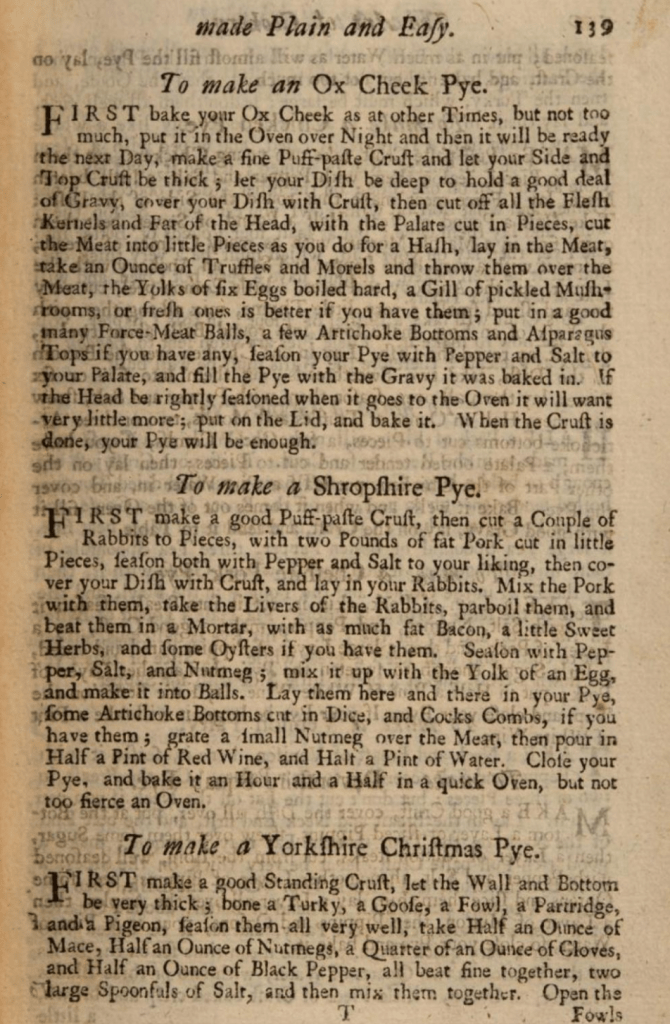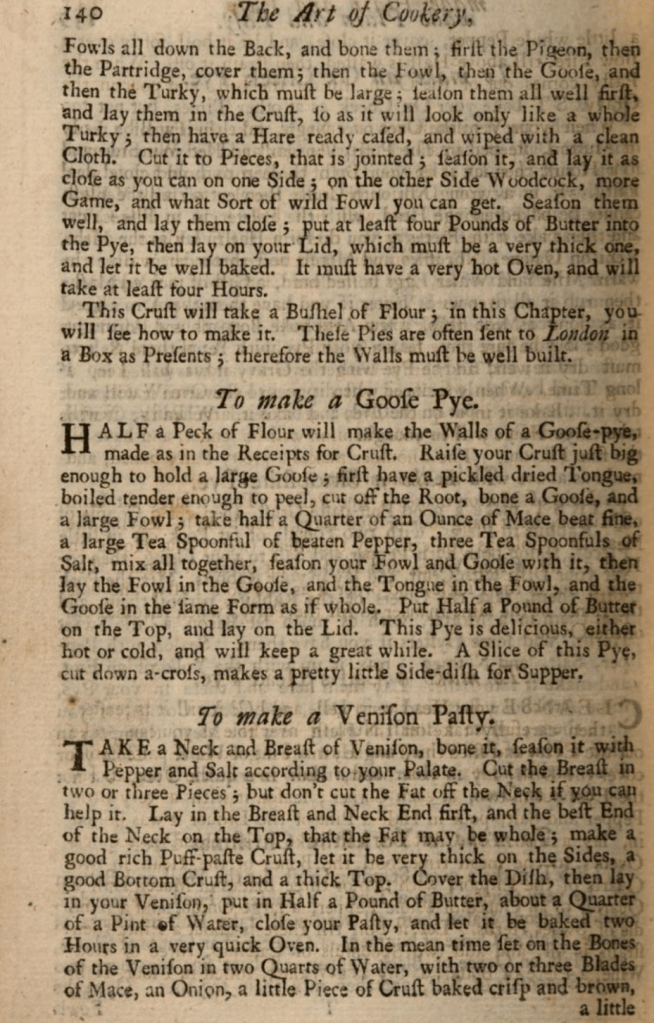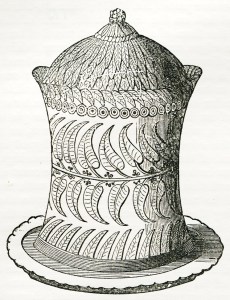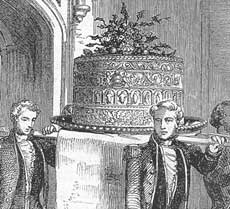
Oh my goodness! Here is a recipe in Jane Grigson’s book, English Food that I never expected to make because it’s so big, expensive and complex: Hannah Glasse’s Yorkshire Christmas Pye. These huge raised pyes were choc-full of meat, usually several species of poultry and game. They were very popular in the nineteenth century, but the first ever recipe appears in Hannah Glasse’s classic cookery book The Art of Cookery Made Plain and Easy, published in 1747. Here it is:


Jane Grigson simply transcribes the recipe, and her advice on its preparation is simple: don’t bother. Hannah’s rather grotesque sounding pye is present in the book to let us know something about the impressive pyes of our past. Instead she suggests making Hannah’s slightly less ostentatious Goose Pye.
The recipe requires 5 birds, deboned, heavily seasoned and stuffed inside the other in order of size, popped into a pastry case with pastry made with a bushel of flour (that’s around 27 kg). Any gaps are filled in with hare, small game birds and a huge amount of butter.
Every Christmas I look at this recipe and wonder how on earth I could make it, but this year I was asked, because I received an email from the folk at Channel 5 who enquired as to whether I would have a go at making a Yorkshire Christmas Pye for their show Our Victorian Christmas. Not only that, but they wanted me to make Hannah’s original recipe – what are the chances of that? The show is due to be broadcast on 22 December at 9 pm, or you can watch it on their streaming service afterwards (I’ll leave a link once its live). I also made some Wassail. Anyway, back to the pye…
The Foods of England website gives us a definition: ‘An extremely large, highly decorated, raised hot-water crust pye filled with a mixture of meats or game in jelly. A celebration pye. Repeatedly mentioned in 18th and 19th Century literature as an indication of good times and full bellies.’1
As we go into the Victorian era, the Yorkshire Christmas Pye becomes more refined, with forcemeat stuffing and gravy being introduced, they also became bigger and more ornately decorated.

If you look at the end of Hannah’s recipe, she says the pyes were actually meant as Christmas gifts to friends and family living in towns and cities. The get there, they would have to travel by coach, and later train, so you can see why huge amounts pastry were required: protection. These huge pyes took a long time to cook, and the pastry would end up being scorched, but its job was to keep in the meat inside well protected, sterile and appealingly moist. Here’s a description of Earl Grosvenor’s Christmas Pye as reported in the Stamford Mercury on 15 January 1808:
At Earl Grosvenor’s second dinner at Chester, as Mayor of that city, on Friday the 1st instant there was a large Christmas pie, which contained three geese, three turkies, seven hares, twelve partridges, a ham, and a leg of veal: the whole, when baked, weighed 154 lbs [70 kg].!2
This was not an isolated case: Queen Victoria had a Christmas Pye so large, it required four footmen to carry it into the dining room!

Pyes such as these were kept for Boxing Day, aka the Feast of Stephen. ‘The concept was to cut off the crust lid, chop up the cooked meat within [and] serve everyone’3 or the meat could be sliced and served with the jellied stock of the meat and spiced butter – delicious! In making a pye like Hannah’s, all one is doing is making a giant version of a classic potted meat or fish (e.g. #268 Potted Shrimps); a layer of meat cooked and sealed in butter – a delicious preservation method.
If you like the blogs and podcast I produce, please consider treating me to a virtual coffee or pint, or even a £3 monthly subscription: follow this link for more information.
Hannah’s recipe must have been a good one – it was heavily plagiarised: I found her recipe in John Farley’s classic The London Art of Cookery (1783) and even an 1882 edition of the Ohio Practical Farmer.4 Neither credit their source.

Hannah didn’t invent the pye though, in fact it seems to be of medieval origin. Raised pyes themselves go back to time where it was much easier and cheaper to form a tough pastry shell rather than purchasing some expensive earthenware in which to cook your meat and vegetables. These pyes appear in medieval manuscripts as ‘coffyns’. This may seem wasteful, but often the flour was stale or was made up of bran and grit, left behind after sifting ground wheat. But the practise of making pyes with a vast array of different meats seems to go back to at least the 14th century, when a special festive pye was made by the Salter’s Company as a gift to the City of London in 1394. It contained – amongst other things – pheasant, hare, capon, rabbit, kidneys, forcemeat, spices and mushrooms.5
So there we have it – a history of the Yorkshire Christmas Pye, but how did I go about making it I hear you ask? Well, I’ll publish the recipe – or my interpretation of it – in another post when the programme airs.
References:
1. Yorkshire Christmas Pie. The Foods of England Project http://www.foodsofengland.co.uk/yorkshirepie.htm.
2. Quote via Sanborn, V. Christmas Pye, Georgian Style, and other British Holiday Foods. Jane Austen’s World https://janeaustensworld.com/2020/12/08/christmas-pye-georgian-style-and-other-british-holiday-foods-by-vic-sanborn/ (2020).
3. DeVito, C. A Jane Austen Christmas: Celebrating the Season of Romance, Ribbons and Mistletoe. (Cider Mill Press, 2015).
4. Ohio Practical Farmer, vol. 61, p.14 (1882).
5. Shanahan, M. Christmas Food and Feasting: A History. (Rowman & Littlefield Publishers, 2019).

If Earl Grosenvor’s pie was 154 lbs that would make it 70 kg (not 65 kg). I only mention it because that is my current weight, and the thought of eating my own body weight in pie sounds rather appealing. 😉
Looking forward to seeing your Yorkshire Christmas Pye on telly.
LikeLike
You’re right! I typed 145 into my calculator by accident. I shall change it. Ta! X
LikeLike
I’m fully expecting Bake Off to demand next year’s contestants to all whap out a fully decorated Yorkshire Christmas Pye for a showstopper in pastry week – and give them around 3 hours to do it in.
LikeLiked by 1 person
Haha. They should! I think I’ll make a more sensible version for the other blog next Christmas…
LikeLike